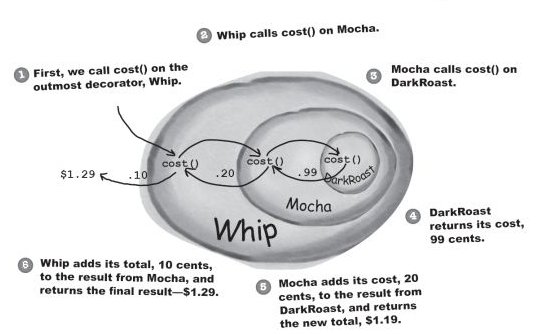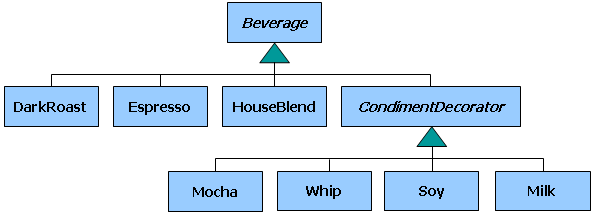

During this lab session:
This activity helps students develop the following skills, values and attitudes: ability to analyze and synthesize, capacity for identifying and solving problems, and efficient use of computer systems.
IMPORTANT NOTE: The lab activities can be developed individually or in pairs. The lab report must be developed individually.
Create a folder called singleton_decorator. Inside
this folder, create four files called:
tigger.rb,
tc_tigger.rb,
coffee.rb, and
tc_coffee.rb.
All Ruby source files must start with a comment containing the lab's title, date, and the authors' personal information. For example:
# Lab 7: Singleton and Decorator Patterns # Date: 16-Oct-2013 # Authors: # 456654 Thursday Rubinstein # 1160611 Anthony Stark
You are given the following Ruby class that models the famous Tigger character from Winnie The Pooh:
# File: tigger.rb class Tigger def to_s return "I'm the only one!" end def roar 'Grrr!' end end
Convert this class into a singleton using whatever technique
you find fit. Place the resulting class in the
tigger.rb source file.
Check your solution using the following test case (place the
test in the source file tc_tigger.rb):
# File: tc_tigger.rb require 'test/unit' require 'tigger' class TiggerTest < Test::Unit::TestCase def test_tigger t = Tigger.instance assert_same(t, Tigger.instance) assert_raise(NoMethodError) do # "new" method should be private! Tigger.new end assert_equal("I'm the only one!", t.to_s) assert_equal('Grrr!', t.roar) end end
This example was taken from [FREEMAN] pp. 79-98. Write the code that allows us to model coffee beverages using the Decorator pattern. The following tables show what beverages and condiments are available, and their corresponding prices:
| Name | Price |
|---|---|
| Dark Roast Coffee | $0.99 |
| Espresso | $1.99 |
| House Blend Coffee | $0.89 |
| Name | Price |
|---|---|
| Mocha | $0.20 |
| Whip | $0.10 |
| Soy | $0.15 |
| Milk | $0.10 |
In our design, the condiments will decorate the beverages. The following Ruby code demonstrates how your code could be used:
beverage = DarkRoast.new beverage = Mocha.new(beverage) beverage = Whip.new(beverage) puts beverage.description puts beverage.cost
For this example, the expected output should be:
Dark Roast Coffee, Mocha, Whip 1.29
The following image depicts the way the decorators work when the
cost method is called from the above code.

The following UML diagram shows the class hierarchy. Each class
needs to implement one or several of these methods:
initialize, description, and
cost.

All these classes should be placed in the coffee.rb
source file.
The following unit tests verify the correct behavior of your
classes. Place the test class in the tc_coffee.rb
source file.
# File: tc_coffee.rb require 'test/unit' require 'coffee' class MyTest < Test::Unit::TestCase def test_espresso beverage = Espresso.new assert_equal("Espresso", beverage.description) assert_equal(1.99, beverage.cost) end def test_dark_roast beverage = DarkRoast.new beverage = Milk.new(beverage) beverage = Mocha.new(beverage) beverage = Mocha.new(beverage) beverage = Whip.new(beverage) assert_equal("Dark Roast Coffee, Milk, Mocha, Mocha, Whip", beverage.description) assert_equal(1.59, beverage.cost) end def test_house_blend beverage = HouseBlend.new beverage = Soy.new(beverage) beverage = Mocha.new(beverage) beverage = Whip.new(beverage) assert_equal("House Blend Coffee, Soy, Mocha, Whip", beverage.description) assert_equal(1.34, beverage.cost) end end
To hand in your individual lab work, follow these instructions.
lab7_report_A0MMMMMMM.txt, where A0MMMMMMM is your student ID. From your AsciiDoc source, generate the corresponding HTML file. That file should be called lab7_report_A0MMMMMMM.html. Place these two files in the singleton_decorator directory.
singleton_decorator directory. Call this file singleton_decorator.tgz. From a terminal, you can use the following command to create this file (make sure to run it at the same level where the singleton_decorator folder resides):
tar czf singleton_decorator.tgz singleton_decorator
Due date is Tuesday, October 22.
This activity will be evaluated using the following criteria:
| 50% | Implementation of functional requirements. |
|---|---|
| 50% | Lab report. |
| DA | The program and/or report was plagiarized. |